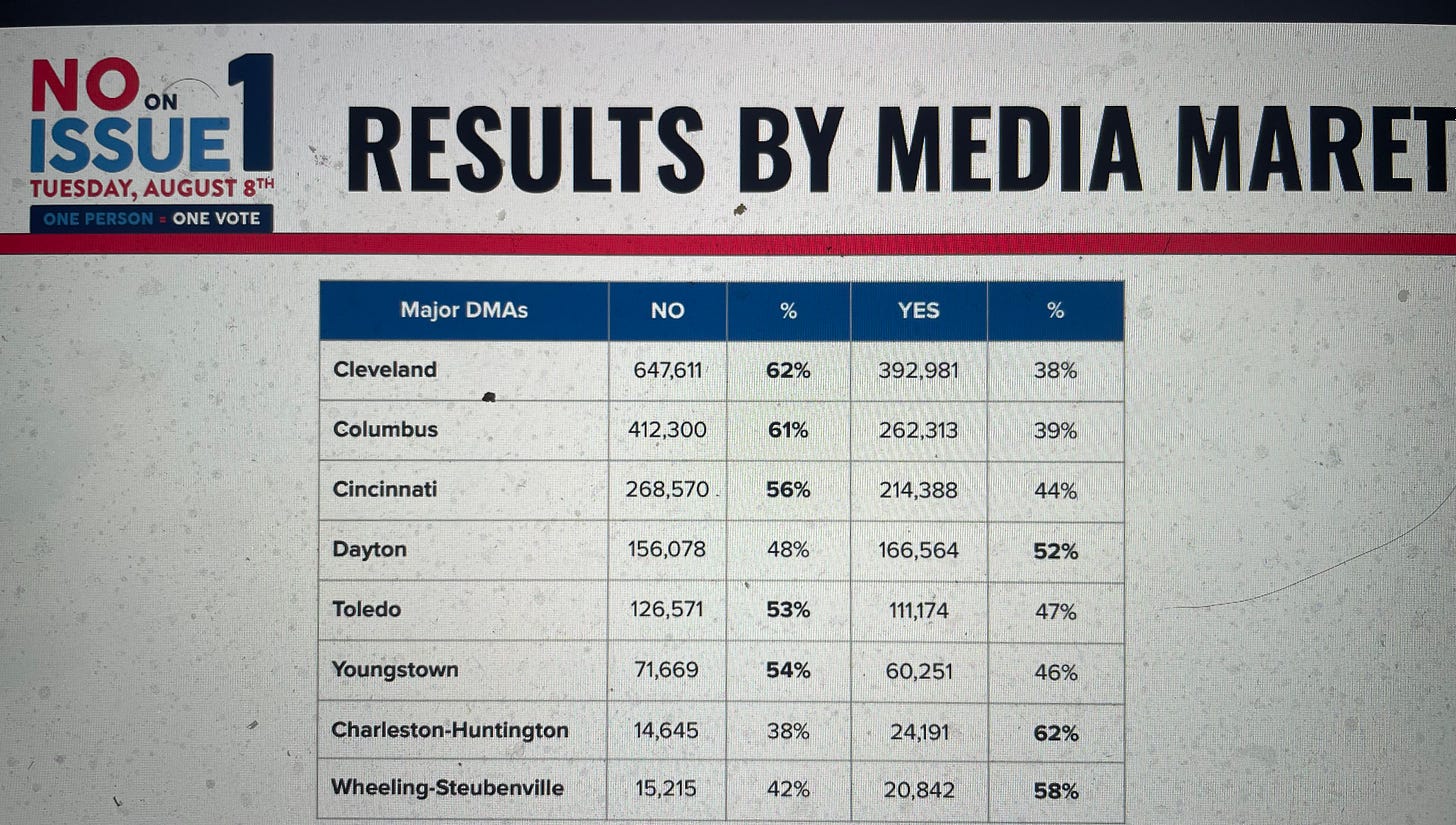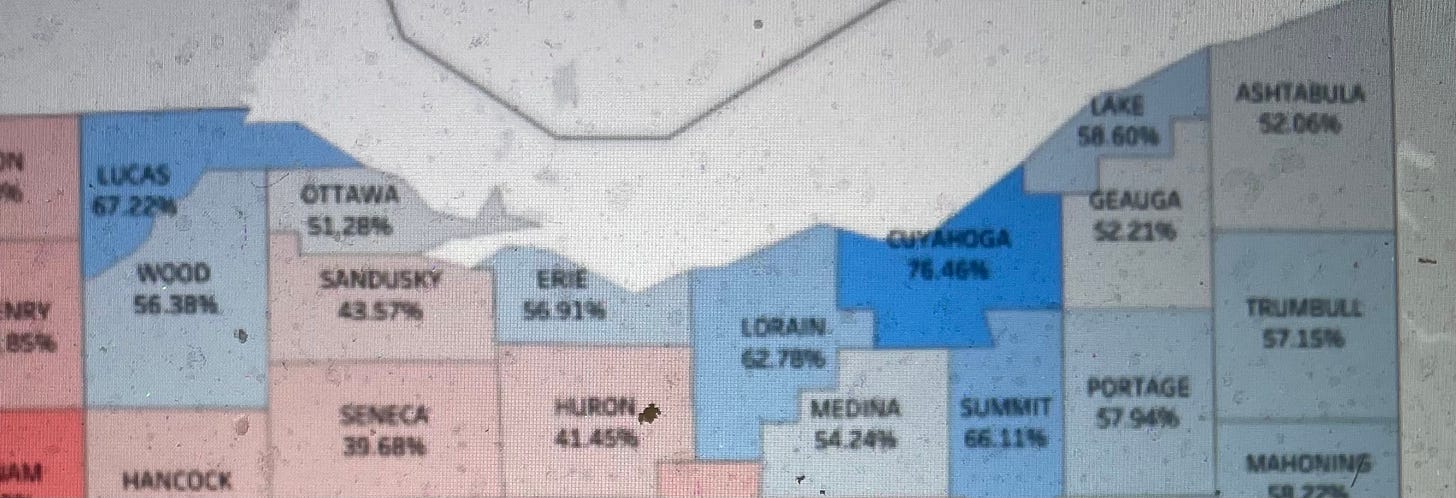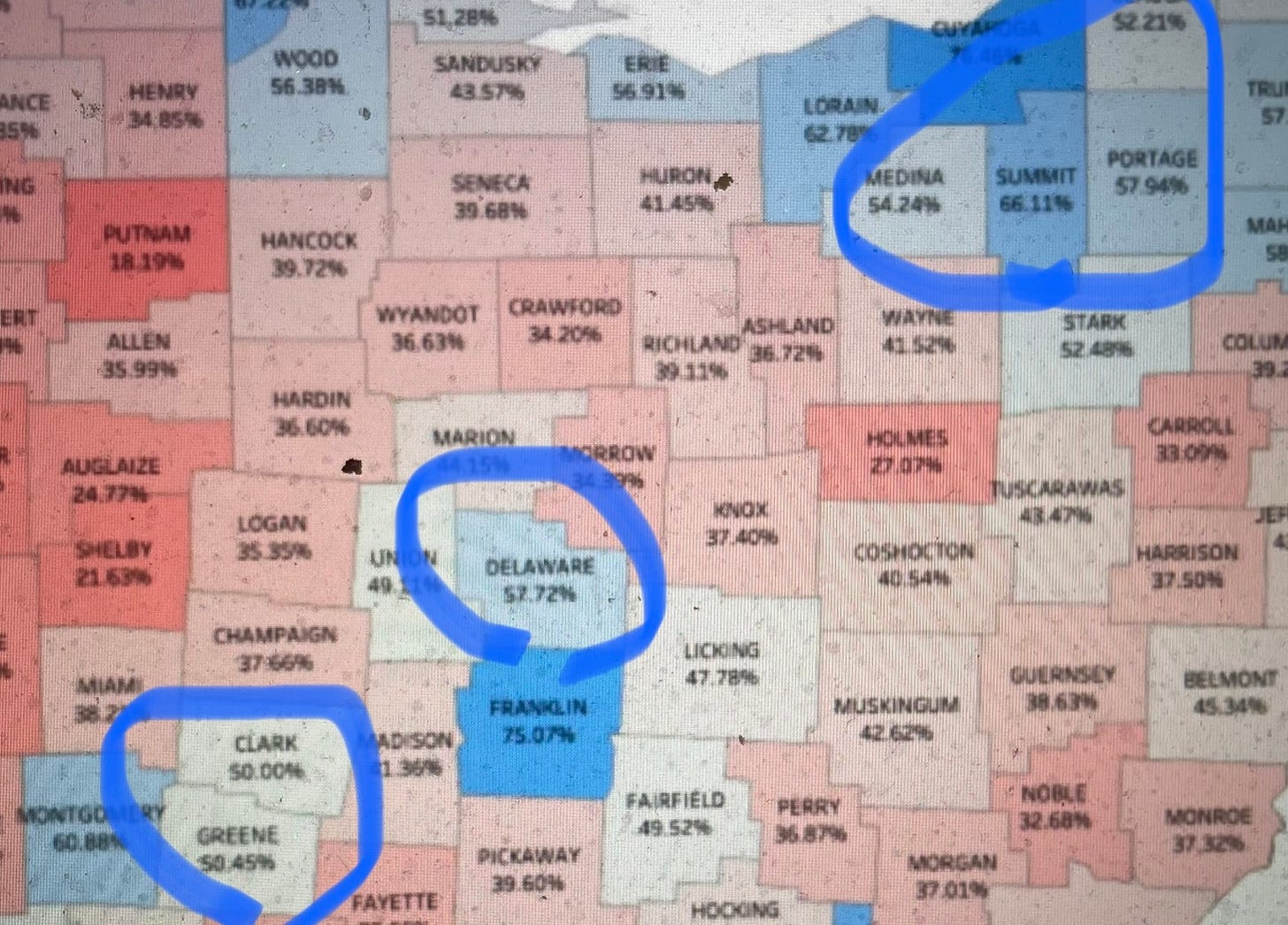A week after the big win for democracy in Ohio, let me share some details on how Issue 1 got so thoroughly drubbed. And what we can learn from it.
Most importantly, the unique 88-county map generated by the Issue 1 “No” vote—and the multi-partisan coalition it represents—provide a pro-democracy baseline for future efforts to lift democracy in Ohio and other states. Most notably, ending gerrymandering.
In the whiteboard above, I walk through a set of trends that anchored the decisive 57-43 demise of Issue 1.
Here are the basics:
Baseline Blue Counties: in 2022, when he overperformed the rest of the ticket, Tim Ryan won eight counties (Ohio’s major cities and near suburbs, and always reliable Athens County). No surprise, those counties came through big against Issue 1 last week. Not only were the margins decisive, but most of these counties saw relatively higher turnout versus the rural red counties where Republican candidates have recently run up big numbers, especially with Trump on the ballot. That differential in turnout in these reliably and large blue counties put the “No” vote in a strong position to win.
But those eight counties were just the beginning. Issue 1 went down in 22 total counties. And these counties make up such a substantial part of Ohio’s population, that meant that Issue 1 lost in five of Ohio’s six largest media markets:
Here are the counties where Issue 1 lost:
Lake Erie Counties: I’ve long said that if you’re a Democrat and want to be President of the United States, all you have to do is win the counties that make up the coast of Lake Erie in Ohio. You do that, and welcome to the White House. Well, Issue 1 lost in every one of those counties, including a number of counties that voted for Trump in both 2016 and 2020.
The Valley: Issue 1 went down to decisive defeat in the heart of “The Valley”—Mahoning (Youngstown) and Trumbull (Warren) Counties.
Old Bellwhether Counties: Not long ago, two counties that were viewed as bellwether counties for Ohio were Wood County (home of Bowling Green) and Stark County (home of Canton). Both voted down Issue 1.
Republican Counties: Perhaps most dramatically, a number of counties that are reliably red voted outright against Issue 1. This included Delaware County, north of Columbus (which has seen a years-long trend from deep red to purple), two counties near Dayton (Greene—home county of Gov. DeWine—and Clark—home to Springfield and John Legend), and three in NE Ohio —Medina, Geauga and Portage Counties. Losing these sizeable counties is where Issue 1 really went from being a loss to a rout.
But we’re still not done: close Republican Counties: a number of counties that usually provide large Republican margins ended up close to 50% opposing Issue 1. This included the large counties surrounding Cincinnati (Butler, Warren and Clermont), counties that ring Columbus (Licking, Fairfield and Union), along with Ross County (Chillicothe) and Belmont County. These close results in numerous sizeable counties deprived the “Yes” side of the margins it would’ve needed to overcome the large margins of loss in “No” counties.
Rural Counties. In recent elections, rural counties—often overlooked by Democrats—have shown up in big ways for the Republican cause: both with high turnout and decisive margins. But for the most part, the turnout in these counties did not keep up with the larger counties; in some counties, it fell under 20%, even as it hit the high 30s and low 40s elsewhere. Voters in these areas were simply not inspired by the “Yes” campaign’s far-right, dishonest and scare-tactic message. And thanks to strong grassroots work in these areas, with activists making the case to swing voters and inspiring “No” voters to show up, the margin of loss in these counties was also lower than in recent elections. Click here for a map on these trends.
Overperformance: one other trend that stuck out was that the “No” vote overperformed versus recent performances for Democrats (including Sherrod Brown in 2018) in counties where there are higher percentages of college educated voters (Butler, Warren, Geauga and Delaware Counties); similar overperformance also took place in the counties that are growing outside major cities, an auspicious trend for the long term.
Add all this up, and what happened last Tuesday was a rout.
And looking ahead, what this map does is provide a blueprint for the future—perhaps not for every candidate or every issue, but, fundamentally, for democracy itself.
Bottom line: a broad coalition of Democrats, independents, Republicans and even Libertarians came together across many divides because they perceived a direct attack on democracy. And across 88 counties, voters from that coalition showed up with energy—many voting against their own party’s endorsement and with people they often disagree with—to stop that attack.
With democracy still at stake in Ohio and so many other states, that is an inspiring coalition worth keeping together.
And specifically, if this coalition rallied to end a shameful and lawless power grab to rig Ohio’s democracy through Issue 1, I can envision a similar coalition being equally energized to end the lawless rigging of Ohio’s democracy known as gerrymandering.
Can’t you?
To get there, we’ve got a lot of thoughtful and hard work to do to keep this precious, pro-democracy coalition unified to save Ohio’s democracy. But last week—and all the effort that went into achieving that outcome—provided a robust and instructive starting point for that work.
Let’s build on what we’ve started.
Much more to come!









Share this post